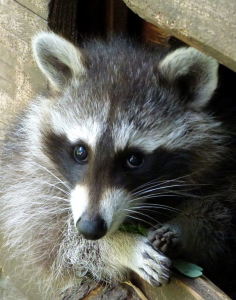 Uninvited house guests can be a tricky situation no matter which species they belong to – but if the houseguests are insects or animals, the coverage on your home insurance policy can be tricky as well. Termites and other wood boring insects might think your house is absolutely delicious or might view your home as a warm and wonderful place to build a nest. Animals have also been known to enter people’s homes, either for a short visit or to build a home of their own. Let’s look at what’s covered, what’s not covered, and some of the concepts that determine coverage eligibility.
Uninvited house guests can be a tricky situation no matter which species they belong to – but if the houseguests are insects or animals, the coverage on your home insurance policy can be tricky as well. Termites and other wood boring insects might think your house is absolutely delicious or might view your home as a warm and wonderful place to build a nest. Animals have also been known to enter people’s homes, either for a short visit or to build a home of their own. Let’s look at what’s covered, what’s not covered, and some of the concepts that determine coverage eligibility.
Coverage for termites and other insects
Termites are the biggest threat to homes when it comes to “vermin”, a broad category of pests that can cause extensive damage and are difficult to control. In many cases, damage due to vermin is not covered by a standard home insurance policy. In fact, damage due to termites is often specifically excluded from coverage. Very few species are mentioned by name in a home insurance policy but termites make the list.
Insurers view termites and similar infestations as a maintenance issue, which makes policing for termites or similar types of vermin the homeowner’s responsibility. If termites are eating your home, your policy isn’t likely to be any help at all. However, in some isolated cases, there may be partial coverage. If you have a collapse at your home due to hidden damage from termites, your insurer might cover the cost of repairing damage due to the collapse itself. For example, if your termite guests chew through a support beam in the basement and part of the house above the support beam collapses, your insurer may pay to repair the areas that are not damaged by termites but won’t pay for the chewed beam that led to the collapse. Even then, the damage to the beam would have to be “hidden damage”, meaning it’s not visible in any way. If the termite damage is visible, it’s likely that there will be no coverage for any of the damage. As homeowners, insurers expect us to be diligent about home maintenance, including repairing pest damage promptly.
Carpenter ants and carpenter bees can also be household nuisances. However, unlike termites, carpenter ants and carpenter bees don’t feed on the wood in your home. They burrow to make nests. Damage from these insects, left unchecked, can still be extensive, so prevention and treatment are important. Expect coverage for damage from these little guys to follow the same guidelines as termites.
Some insurers may also require a termite inspection prior to insuring the home. This is because in the event of a covered claim due to causes other than termite damage, a home with heavy termite damage may require more extensive repairs to ensure safety or meet building code requirements.
Often the best defense against termites is to contract with a termite inspection company that can check for termites and similar pests regularly and provide treatment if there is any evidence of a nest. Avoid excess storage of cellulose (wood, paper, and cardboard) or wood that touches the ground. Also, seal gaps around exterior pipes and look for ways to reduce moisture in your home.
Unfortunately, insurers don’t cover the cost of pest inspections or home treatments to prevent or remedy pest infestations but if you choose a good company, the money you spend is well-invested.
Coverage for rodents, raccoons, squirrels, and other animals
Once we begin discussing pests that are larger than insects, some sorting into groups needs to take place to better understand your coverage. Rodents, like termites, are often specifically excluded from coverage on a standard home insurance policy, so let’s discuss rodents first.
Rats, mice, and even cute chipmunks and squirrels are all rodents and can create extensive damage in a home. In most cases, the physical damage caused by these little guys isn’t covered – nor is the cost of their removal if you choose to call in a pest control specialist to handle a rogue squirrel in the attic or a family of mice living in the pantry walls.
There are some isolated exceptions where an insurer may provide coverage for damage from rodents. For example, if a mouse chews through wires in your home, causing a fire, the fire damage is likely to be covered – however, there may still be some challenges. If you knew about the mouse, squirrel, chipmunk, etc. and didn’t take measures to remove the pests from your home, the insurer may deny coverage, deeming the damage to be due to a “lack of maintenance”. If the insurance adjuster finds obvious and unmistakable signs of a colony of mice living in your home after the chewed-wire fire claim, damage from the fire may not be covered or you may have to fight to have the claim covered. It’s always best to evict your unwanted house guests as soon as you notice they’ve moved in. By the way, a squirrel’s teeth never stop growing, so squirrels chew and chew and chew to keep their teeth from growing too long.
Not all animals are rodents
Raccoons aren’t rodents, nor are bats, deer, bears, or some other types of animals that sometimes invite themselves into homes. Coverage may be limited in some cases, but coverage for these “non-rodent” guests is less limited than in the case of rodents or vermin. Many courts don’t consider raccoons or bats to be vermin, which are often excluded from coverage, but your insurer may feel differently and a claim due to damage from raccoons or bats may not be covered. Some policies also specifically exclude coverage for damage caused by raccoons and bats. In other cases, a bat infestation, for example, damage to structural items like attic insulation may be covered but the insurer may not cover the removal of the bat “guano” or the bats themselves, meaning there is only partial coverage.
Damage caused by your own pets
Coverage for damage caused by your own pets or animals in your care also varies depending on the situation. The most damaging way pets can behave is by biting people, with dog bites being the leading cause of home insurance liability claims and the average dog bite claim exceeding $30,000. For this reason, many home insurers exclude coverage for certain breeds of dogs, dogs with a bite history, or dogs who have been trained to fight. In some cases, insurers won’t write a policy for a household that has what the insurer has deemed to be “dangerous” dogs. If your pet isn’t excluded from coverage, your liability coverage provides protection but examine the coverage limits carefully. Dog bite liability claims can lead to financial exposure well above the average of $30,000, sometimes rising as high as 6 or even 7 figures.
Dog bites may be covered in many cases, but if Fido (or Fluffy) chews the drywall, cabinet doors, or even your new laptop computer, your home insurance won’t cover the damage. The same is true for other animals in your care temporarily. However, if Fido chews through your neighbor’s fence, your home insurance policy may provide coverage under the personal liability section of your policy.
Wild animals
More rural areas sometimes have larger visitors, like deer or even bears. If one of these animals enters your home and starts breaking things, coverage is mixed, meaning some of the damage may be covered while other items may not be covered. The distinction is due to the different coverage types in a standard home insurance policy and which risks are covered by each type of coverage.
“Coverage A” is coverage for the dwelling. This is the house and its attached structures. An eight-point buck running amok in your home can cause damage to the structure including damage to windows, doors, drywall, and similar vulnerable areas. On a standard (HO-3) home insurance policy, the dwelling is covered for all perils – except those that are specifically excluded. It’s unlikely that eight-point bucks are specifically excluded on your policy, so damage to the structure should be covered. “Coverage B”, other structures, usually covers the same risks as coverage A, so rogue-animal damage to other structures such as detached garages would be covered as well.
“Coverage C” is where you’re more likely to have exposure to a loss due to a rogue animal. Coverage C is coverage for personal property, your electronics, furnishings, etc. On most policies, coverage is limited to specifically named perils. You can bet that eight-point bucks aren’t on the list so if the deer breaks things other than the building structure, there probably won’t be covered. If the rogue deer knocked over a candle and started a fire, however, fire is a covered peril.
Understanding sudden and accidental damage
There are certain phrases that appear commonly in most home insurance policies. “Sudden and accidental” is among the common phrases and is relevant to any discussion of damage caused by insects or animals. Home insurance isn’t intended to be a maintenance policy. The earliest home insurance policies only covered fires. That’s all. Newer policies are much broader in coverages but still focus coverage on the sudden damage that occurs accidentally.
Many of the ways in which vermin can damage a home aren’t sudden at all. A lightning strike is sudden (and it’s covered!) but a colony of insects or a family of mice living in your home will usually require quite a bit of time to cause significant damage. There should be some signs during that time and the best solution is to remedy the problem before any significant damage occurs. Understanding the concept of coverage for sudden and accidental occurrences can guide you in understanding how many parts of your home insurance policy are structured.




![IBA Top Retail Brokers 2024 Medal[88] IBA's Top Retail Broker 2023](https://coastalinsurancesolution.com/wp-content/uploads/2024/07/IBA-Top-Retail-Brokers-2024-Medal88.png)



